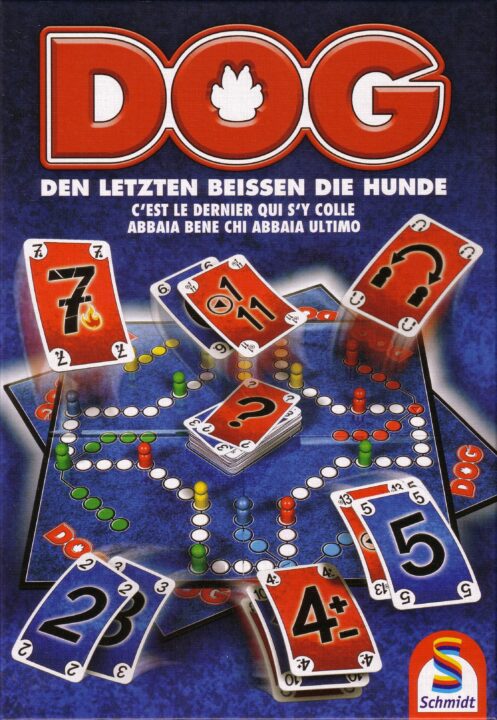How To Play: DOG
DOG's strategy guide covers crucial areas such as team coordination, card management, and tile placement. Master strategies include prioritizing high-value cards, blocking opponents, and balancing risk. Remember, strong team communication is key. Practice and teamwork will elevate your gameplay. For more tips and insights, check out our full guide on how to play DOG.

Hey fellow board game enthusiasts! Welcome to our ultimate DOG strategy guide. Here, you’ll find an outline of the game rules and the best strategies to help you crush your opponents. Whether you’re a newbie or a seasoned player, this guide has something for everyone. Get ready to master DOG and lead your team to victory!
Overview
# What’s in the box
- 110 cards
- 4 game pieces
- 1 game board
- 1 set of instructions
- 6 special tiles
- 1 scorepad
- 10 player tokens
How To Play DOG: Rules Summary
Setup
-
Place the game board in the center of the table.
-
Each player chooses a color and takes their set of pawns.
-
Shuffle the deck of cards and deal a hand to each player.
-
Players place their pawns in the starting area on the board.
Gameplay
-
Players take turns moving their pawns according to the cards played.
-
On your turn, play a card and move a pawn based on the card’s value.
-
You may play certain action cards for special moves like swapping pawns.
-
Draw a new card at the end of your turn to keep your hand full.
Winning
-
The first player to get all their pawns to the finish area wins.
Special Rules & Conditions
-
If you land on an opponent’s pawn, you send it back to their start.
-
Some cards allow unique moves, so read them carefully before playing.
-
Only one pawn can occupy a space at a time.
Best DOG Strategies
Mastering Team Coordination and Planning in DOG
Playing DOG with friends can be a riot, but winning? That’s sweet. You need solid team coordination and planning. Here’s a guide.
Understanding Your Teammates
-
Know their strengths and weaknesses.
-
Communicate your strategy clearly.
-
Plan based on individual skills.
Effective Communication
-
Discuss moves before the game starts.
-
Use code words or signals during play.
-
Keep everyone updated on the game’s status.
Adaptability
-
Adjust plans based on opponents’ actions.
-
Be flexible with your strategies.
-
React swiftly to changes.
Mastering Card Management in DOG
Card management can make or break your game of DOG. Here are a few strategies to help you outlive your opponents and rule the board.
Prioritize High-Value Cards
You must know when to play high-value cards. Use them wisely.
- Save them for critical moves.
- React fast to opponents’ moves with your best plays.
- Use high-value cards to secure key tiles.
Balance Your Hand
Keep a good mix of cards. This flexibility can turn the tide in your favor.
- Avoid a hand full of low-value cards.
- Always aim for a balance between attack and defense cards.
- Trade cards with teammates if needed.
Know When to Discard
Sometimes, less is more. Discarding the right cards can be a smart move.
- Drop cards that do not fit your current strategy.
- Make room for better cards down the line.
- Communicate with your team to make better discard choices.
Observe Opponents
Watch your foes’ plays closely. This helps in deciding which cards to keep or play.
- Note patterns in opponents’ card usage.
- Hold back cards that counter their strategy.
- Adjust to their tactics on the fly.
Team Communication
Good teamwork can amplify your card management strategy.
- Share your card plans with teammates.
- Coordinate which cards to save and which to play.
- Back up each other’s moves for maximum impact.
Mastering Tile Placement Techniques to Win DOG
Plan Ahead
First, always plan your moves a few steps ahead. This helps in avoiding dead ends.
- Identify your target tiles.
- Think about how to connect them efficiently.
Block Opponents
Next, consider blocking your opponents. Keep them from forming strong paths.
- Place tiles that disrupt their routes.
- Observe and anticipate their moves.
Work with Your Partner
Moreover, coordinate with your teammate. This can turn the tide in your favor.
- Share your strategies.
- Support each other’s moves.
Balance Risk and Reward
Finally, balance risky plays with safe ones. Sometimes, a bold move wins big.
- Evaluate potential gains.
- Assess the risks involved.
## Wrapping Up Your DOG Journey!
And there you have it, folks! Those who follow these tips will see an improvement in their DOG game. Trust me, I’ve played countless rounds and got the scars to prove it! But don’t just rely on my tales of glory and defeat. Take these strategies, play with your friends, and find out what works best for your pack. Always remember to keep an eye on your cards, collaborate with your teammate, and watch your opponents like a hawk. The more you play, the better you’ll get. Now go on, grab your board, and may the best team win!
If you want to learn more about how to play DOG, just ask me, and I’ll give you more bark than you can handle.
Want to know what we think of DOG? Read our detailed review of DOG here

